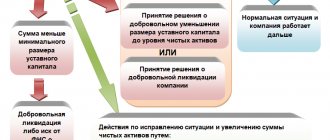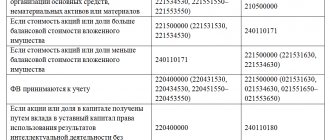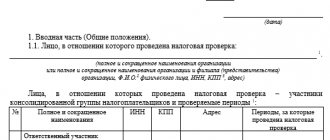Olga Golovina, financial director and product specialist of the My Business Finance service, talks about the organization’s net assets and the importance of this indicator for entrepreneurs.
Olga Golovina
Financial Director, product specialist of the “My Business Finance” service
Last week Evgeniy dealt with interest coverage ratios and financial dependence. Now he takes a balanced approach to lending to production and determines the financial stability of the business. Today, the entrepreneur will get acquainted with net assets and express assessment of management efficiency.
Come with Evgeniy to my free online course “Management Accounting for Owners of Medium-Sized Businesses” to figure out how to organize management accounting for your business and make informed management decisions.
Net assets and authorized capital
Simply put, net assets are the difference between a company's assets and liabilities.
This difference can be either positive or negative. A negative difference indicates that if the company decides to pay off all its obligations to third parties, then it will not have enough own funds. Positive indicates the financial stability of the company.
Authorized capital is the amount that the owners of a company contribute when creating and registering it - with money, property, securities, etc. This amount is fixed in the company's charter, and the minimum possible amount of authorized capital for each organizational and legal form is approved at the legislative level.
Read in the berator “Practical Encyclopedia of an Accountant”
Minimum authorized capital
And net assets may turn out to be less than the company's authorized capital. If this occurs at the very beginning of the company’s activities, then such a result can be temporarily considered normal. He says that it existed at the expense of the authorized capital.
In the future, in order to claim a company’s good financial position, its net assets must exceed its authorized capital. That is, the invested funds are not spent, but multiplied, which means the company is operating efficiently.
Read in the berator “Practical Encyclopedia of an Accountant”
How to determine the amount of a company's net assets
How to calculate net assets
Formula for calculating net assets:
Net Assets = (Assets – Receivables of founders for contributions to the authorized capital) – (Liabilities – Deferred income).
The procedure for calculating the value of net assets was approved at the legislative level in Order of the Ministry of Finance of the Russian Federation dated August 28, 2014 No. 84n.
Net assets are not directly reflected on the balance sheet. The indicator is derived using a formula using information from the accounting or management balance sheet. I advise you to use the second one, because for small and medium-sized businesses it reflects the real situation:
- assets - line 1600;
- obligations - line 1400 + line 1500;
- deferred income - line 1530.
With the receivables of the founders for contributions to the authorized capital (read - own investments in business development) it is more difficult. If the balance sheet does not list accounts receivable by item, you will have to go into accounting and look at the balance in the debit of account 75.1 “Calculations for contributions to the authorized (share) capital.”
Beginning entrepreneurs often ask me whether it is possible to do without these accounts receivable from the founders? No, because if we take into account future revenues from the owners, the indicator will not reflect the real situation of the business. Payments planned in 2-3 months do not yet belong to the company, and we need to know how much money will remain after paying off the debts at the moment.
Deferred income typically includes government assistance and gifts. “On paper” they are considered obligations, although, in fact, they are not such. This is an interesting feature of Russian accounting. There is nothing you can do about it, you just need to take it into account when assessing the value of the organization’s net assets.
If net assets are less than authorized capital
It is not without reason that the annual report forms include a report on changes in capital, which reflects data on the company’s net assets over time - for the reporting year and the two preceding ones.
If during this period net assets were less than the authorized capital, then:
- An LLC is obliged to either reduce its authorized capital or carry out a liquidation procedure (Article 30 of the LLC Law);
- The JSC is obliged to either reduce the authorized capital, or carry out a liquidation procedure, as well as publish a notice in the media about the decrease in the value of net assets, if it was traced for 3, 6 and 9 months of the reporting year (clauses 35, 36 of the Law on JSC).
At the same time, the liquidation of companies whose authorized capital has been less than net assets for 2 years or more is carried out by the tax authority forcibly (Clause 11, Article 7 of the Law “On Tax Authorities” of March 21, 1991 No. 943-I) .
However, before a decision on liquidation is made, the company has the right to take measures to eliminate the situation that created it. And for this there are two ways: either reduce the authorized capital, or increase net assets.
Estimate net assets
“Net assets” is not just a term from economic theory. By calculating this indicator, you can assess the “health” of the company, learn about its financial stability, and justify the possibility of paying dividends. And sometimes the very existence of a company depends on the size of its net assets.
L. Izotova The net assets of a company are actually its own capital.
That is, assets free from all debt obligations. So the more of them, the more efficient the company’s work. Joint-stock companies (closed and open) and limited liability companies are required to monitor the amount of net assets. After all, if this indicator becomes less than the authorized capital, then the “charter” will have to be reduced, and the payment of dividends can be forgotten for a while (Articles 35, 43 of the Law of December 26, 1995 No. 208-FZ “On Joint-Stock Companies”, Art. 20, 29 of the Law of February 8, 1998 No. 14-FZ “On Limited Liability Companies”). Those companies whose authorized capital, as a result of recalculation, turns out to be less than the permissible minimum (currently for LLCs and CJSCs - 10,000 rubles, for OJSCs - 100,000 rubles) will have to be liquidated.
This requirement of legislators is quite understandable. After all, entrepreneurial activity should be aimed at “systematic receipt of profit” (Clause 1, Article 2 of the Civil Code). Therefore, over time, the company's equity capital should grow. And if it decreases, moreover, it becomes less than the initially invested funds, then this means the financial instability of the society. The disappointing conclusion can be drawn that the company spends more than it earns.
In such conditions, the owners are obliged to either take urgent measures to correct the situation or liquidate the company. Otherwise, the company may be closed by court decision. Similar situations occur in arbitration practice (resolutions of the FAS East Siberian District dated November 19, 2002 No. A74-4154/01-K2-F02-3401/02-S2, FAS Far Eastern District dated July 25, 2006 No. F03-A73 /06-1/2138). So the net asset indicator is of no small importance and monitoring its dynamics is vital for any company. Let's figure out how to calculate it.
One formula for everyone
Net assets can be easily calculated using data from the balance sheet. To do this, the amount of liabilities is subtracted from the amount of assets. True, not all balance sheet indicators are included in the calculation. Thus, the value of own shares purchased from shareholders and the debt of the founders for contributions to the authorized capital must be excluded from the assets. And the liabilities do not take into account capital and reserves (section III) and deferred income (code 640 of section V). All data should be taken from the company’s latest duly approved balance sheet.
This calculation procedure has been adopted for joint-stock companies (Order of the Ministry of Finance dated January 29, 2003 No. 10n, FCSM No. 03-6/pz). There is no regulatory document for calculating the net assets of limited liability companies. Specialists from the main financial department believe that LLCs can use the rules developed for JSCs (letter of the Ministry of Finance dated January 26, 2007 No. 03-03-06/1/39). The arbitrators adhere to similar conclusions (resolution of the Federal Antimonopoly Service of the Ural District dated April 18, 2006 No. F09-2886/06-S5).
The amount of net assets does not have to be calculated independently. Its meaning can be found in the reference to Form No. 3 “Report on Changes in Capital” (Order of the Ministry of Finance dated July 22, 2003 No. 67n).
Having found out the required figure, all that remains is to compare it with the amount of the authorized capital (code 410, section III of the balance sheet). What if the conclusion is not in favor of the company? Are there any ways to increase your net asset value?
We need to work better
Having carefully studied the procedure for calculating net assets, we can conclude that to solve the problem it is necessary to increase the company’s assets and reduce the indicators of sections IV and V of liabilities, that is, reduce the amount of long-term and short-term liabilities. How to achieve this? For example, by managing accounts receivable and payable, increasing the efficiency of the company, analyzing profitability and pricing policy, and cost planning. However, if a solution is needed immediately, then such “correct” methods will not work. After all, they are designed for the future.
Maybe just take out a loan or credit? No. Unfortunately, borrowing money or a bank loan will not help increase net assets. The fact is that, for example, when accounting for a loan, the accountant makes an entry to the debit of account 51 and the credit of account 66 “Settlements for short-term loans and borrowings.” Thus, both the active and passive parts of the balance will be increased by the amount received. And the amount of net assets will remain the same.
But still, the company has ways to increase its own capital. You can, for example, reassess the value of the company's property, attract additional investments, or merge with another company. Let's look at each of these methods.
We will evaluate the property
Revaluation of fixed assets does not provide real capital growth. It only improves the results “on paper”. A company can revaluate its property once a year. The results must be reflected in the balance sheet at the beginning of the reporting period, that is, on January 1 (clause 15 of PBU 6/01, approved by order of the Ministry of Finance dated March 30, 2001 No. 26n).
According to the accounting rules, the amount of additional assessment of the value of property will be taken into account as the debit of account 01 “Fixed assets” and the credit of account 83 “Additional capital”. But capital indicators are not included in the calculation of net assets. Consequently, their cost will increase, and we will solve the problem.
By the way, the results of the revaluation of fixed assets do not need to be included in income when calculating income tax (clause 1 of Article 257 of the Tax Code).
Let's ask for help
Another possible option for increasing assets is to receive gratuitous assistance. It’s better if the founders or shareholders come to the rescue. After all, such gifts will only be excluded from the base for calculating income tax if the donor owns more than 50 percent of the authorized capital (subclause 11, clause 1, article 251 of the Tax Code). Otherwise, you will have to take into account that the liability balance will increase by 24 percent (income tax rate) of the market assessment of the value of the gratuitous deposit.
So, having received free property, it is reflected in the debit of the asset accounting accounts. For example, 01 “Fixed assets” or 10 “Materials”, or 51 “Current account”. And on the credit of account 98 “Deferred income”, subaccount 2 “Gratuitous receipts”. As you know, “deferred income” is not taken into account when calculating net assets, which means it will not reduce the amount of the increased asset.
We are reorganizing the company
Reorganization is probably the most difficult method suggested above. But sometimes it can be the most effective. For example, when operating a group of companies, merging two companies can result in a significant increase in the size of the active part of the balance sheet. Thereby achieving an improvement in the net asset ratio. Moreover, most likely there will be no tax consequences. After all, during reorganization, “the value of property, property and non-property rights received through succession is not taken into account as income” (clause 3 of Article 251 of the Tax Code). However, we must not forget about obligations. They will also have to be combined. So, before deciding to merge, it is necessary to evaluate not only the assets, but also the accounts payable, loans and credits of the upcoming “ally”.
Hello Guest! Offer from "Clerk"
Online professional retraining “Chief accountant on the simplified tax system” with a diploma for 250 academic hours . Learn everything new to avoid mistakes. Online training for 2 months, the stream starts on March 1.
Sign up
How to equalize net assets and authorized capital
In accordance with Article 90 of the Civil Code of the Russian Federation, if the size of net assets is less than the authorized capital, their values must be equalized. There are two ways to do this:
- reduce the authorized capital;
- increase net assets.
Reducing the authorized capital requires amendments to the charter and their state registration. In addition, if net assets turn out to be less than the minimum allowable amount of the authorized capital, it is impossible to equalize their amounts by reducing the size of the authorized capital.
Therefore, you will have to increase your net assets. And this can also be done in two ways.
The first is the contribution of money or property to the company by the owners. In this case, these funds will be classified as other income. This will lead to an increase in retained earnings and, accordingly, net assets.
What if the founders do not have such an opportunity?
Then the second way remains - to revaluate fixed assets and intangible assets. This must be done before the end of the financial year and reflected in accounting as of December 31. So there is an opportunity to improve your financial performance, and the tax office will not threaten you with liquidation.
As a result of revaluation, the initial cost of objects will be brought into line with their market value. True, the amount of accrued depreciation is also recalculated. But in any case, the results will affect the amount of equity capital. A timely revaluation can improve the financial performance of the company and avert (at least temporarily) the threat of liquidation.






